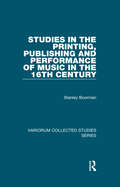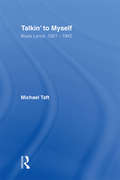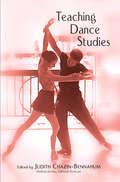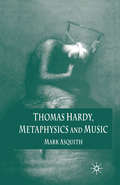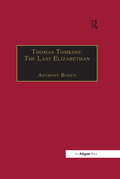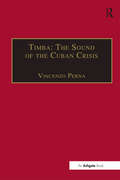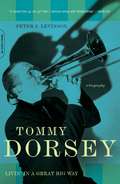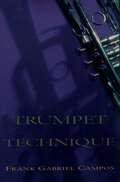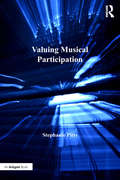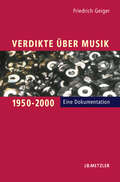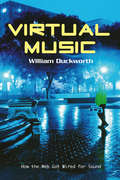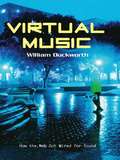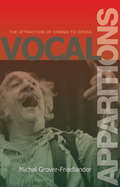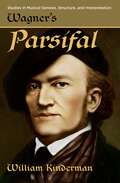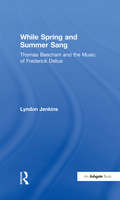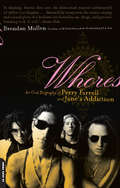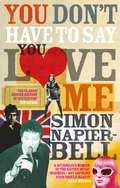- Table View
- List View
Studies in the Printing, Publishing and Performance of Music in the 16th Century
by Stanley BoormanThe emergence of music printing and publishing in the early 16th century radically changed how music was circulated, and how the musical source (printed or manuscript) was perceived, and used in performance. This series of close studies of the structure and content of 16th-century and early 17th-century editions (and some manuscripts) of music draws conclusions in a number of areas - printing techniques for music; the habits of different type-setters and scribes, and their view of performing practice; publishers' approaches to the musical market and its abilities and interests; apparent changes of plan in preparing editions; questions of authorship; evidence in editions and manuscripts for interpreting different levels of notation; ways in which scribes could influence performers' decisions, and others by which composers could exploit unusual sonorities.
Studies in the Printing, Publishing and Performance of Music in the 16th Century
by Stanley BoormanThe emergence of music printing and publishing in the early 16th century radically changed how music was circulated, and how the musical source (printed or manuscript) was perceived, and used in performance. This series of close studies of the structure and content of 16th-century and early 17th-century editions (and some manuscripts) of music draws conclusions in a number of areas - printing techniques for music; the habits of different type-setters and scribes, and their view of performing practice; publishers' approaches to the musical market and its abilities and interests; apparent changes of plan in preparing editions; questions of authorship; evidence in editions and manuscripts for interpreting different levels of notation; ways in which scribes could influence performers' decisions, and others by which composers could exploit unusual sonorities.
Talkin' to Myself: Blues Lyrics, 1921-1942
by Michael TaftTalkin' to Myself: Blues Lyrics, 1921-1942 is a compendium of lyrics by the great blues recording artists of the classic blues era. It includes over 2000 songs, transcribed directly from the original recordings, making it by far the most comprehensive and accurate collection of blues lyrics available.
Talkin' to Myself: Blues Lyrics, 1921-1942
by Michael TaftTalkin' to Myself: Blues Lyrics, 1921-1942 is a compendium of lyrics by the great blues recording artists of the classic blues era. It includes over 2000 songs, transcribed directly from the original recordings, making it by far the most comprehensive and accurate collection of blues lyrics available.
Teaching Dance Studies
by Judith Chazin-Bennahum Melinda JordanTeaching Dance Studies is a practical guide, written by college professors and dancers/choreographers active in the field, introducing key issues in dance pedagogy. Many young people graduating from universities with degrees – either PhDs or MFAs – desire to teach dance, either in college settings or at local dance schools. This collection covers all areas of dance education, including improvisation/choreography; movement analysis; anthropology; theory; music for dance; dance on film; kinesiology/injury prevention; notation; history; archiving; and criticism. Among the contributors included in the volume are: Bill Evans, writing on movement analysis; Susan Foster on dance theory; Ilene Fox on notation; Linda Tomko addresses new approaches to teaching the history of all types of dance; and Elizabeth Aldrich writing on archiving.
Teaching Dance Studies
by Judith Chazin-BennahumTeaching Dance Studies is a practical guide, written by college professors and dancers/choreographers active in the field, introducing key issues in dance pedagogy. Many young people graduating from universities with degrees – either PhDs or MFAs – desire to teach dance, either in college settings or at local dance schools. This collection covers all areas of dance education, including improvisation/choreography; movement analysis; anthropology; theory; music for dance; dance on film; kinesiology/injury prevention; notation; history; archiving; and criticism. Among the contributors included in the volume are: Bill Evans, writing on movement analysis; Susan Foster on dance theory; Ilene Fox on notation; Linda Tomko addresses new approaches to teaching the history of all types of dance; and Elizabeth Aldrich writing on archiving.
Thomas Hardy, Metaphysics and Music
by Mark AsquithThis fascinating new study by Mark Asquith offers an original approach to Hardy's art as a novelist and entirely new readings of certain musical scenes in Hardy's works. Asquith utilizes a rich seam of original archival research (both scientific and musicological), which will be of use to all Hardy scholars, and discusses a range of Hardy's major works in relation to musical metaphors - from early fiction The Poor Man and the Lady to later major works Jude the Obscure, Far From the Madding Crowd, the Mayor of Casterbridge .
Thomas Tomkins: The Last Elizabethan
by Anthony Boden Denis Stevens Bernard Rose Peter James David R.A. EvansThomas Tomkins (1572-1656), a major figure of the Golden Age of British music, was arguably the greatest of all Welsh-born composers. Living through one of the most revolutionary periods in British history, his professional life was spent in the service of the Crown and the Church at both the Chapel Royal and Worcester Cathedral. Surviving the Civil War, the suppression of the music of the English Church, the closure of the Chapel Royal, the destruction of his organ at Worcester and the devastation of the city, Tomkins was able to find the strength and inspiration to continue composing secular music of fine quality. Much of Tomkins's output has survived, including his collection of music for the Anglican rite, Musica Deo Sacra, published posthumously in 1668. His work embraced both sacred and secular vocal music, pieces for keyboard and for viol consort, thereby proving him to be one of the most versatile figures of English Renaissance music. The first part of the book provides an absorbing biography of Tomkins, setting his life into fascinating historical context. The second and third parts include major essays on Tomkins by Denis Stevens, Bernard Rose, Peter James and David Evans, all authorities on the music of the period with each providing perceptive insights into Tomkins's music. The result is a successful piece of collective work that properly places Tomkins and his achievements in his time and enables readers to reassess him properly in relation to his elders and contemporaries. Tomkins has still not reached the 'household name' status of his great teacher, William Byrd, or of his close friend and colleague, Orlando Gibbons, but he is undoubtedly worthy of much greater recognition. The book complements the increasing number of live performances and recordings of Tomkins's music, both sacred and secular, and such a comprehensive account of the man and his work should appeal to early music scholars, performers and music lovers alike.
Thomas Tomkins: The Last Elizabethan
by Anthony BodenThomas Tomkins (1572-1656), a major figure of the Golden Age of British music, was arguably the greatest of all Welsh-born composers. Living through one of the most revolutionary periods in British history, his professional life was spent in the service of the Crown and the Church at both the Chapel Royal and Worcester Cathedral. Surviving the Civil War, the suppression of the music of the English Church, the closure of the Chapel Royal, the destruction of his organ at Worcester and the devastation of the city, Tomkins was able to find the strength and inspiration to continue composing secular music of fine quality. Much of Tomkins's output has survived, including his collection of music for the Anglican rite, Musica Deo Sacra, published posthumously in 1668. His work embraced both sacred and secular vocal music, pieces for keyboard and for viol consort, thereby proving him to be one of the most versatile figures of English Renaissance music. The first part of the book provides an absorbing biography of Tomkins, setting his life into fascinating historical context. The second and third parts include major essays on Tomkins by Denis Stevens, Bernard Rose, Peter James and David Evans, all authorities on the music of the period with each providing perceptive insights into Tomkins's music. The result is a successful piece of collective work that properly places Tomkins and his achievements in his time and enables readers to reassess him properly in relation to his elders and contemporaries. Tomkins has still not reached the 'household name' status of his great teacher, William Byrd, or of his close friend and colleague, Orlando Gibbons, but he is undoubtedly worthy of much greater recognition. The book complements the increasing number of live performances and recordings of Tomkins's music, both sacred and secular, and such a comprehensive account of the man and his work should appeal to early music scholars, performers and music lovers alike.
Timba: The Sound of the Cuban Crisis
by Vincenzo PernaCuban music is recognized unanimously as a major historical force behind Latin American popular music, and as an important player in the development of US popular music and jazz. However, the music produced on the island after the Revolution in 1959 has been largely overlooked and overshadowed by the Buena Vista Social Club phenomenon. The Revolution created the conditions for the birth of a type of highly sophisticated popular music, which has grown relatively free from market pressures. These conditions premised the new importance attained by Afro-Cuban dance music during the 1990s, when the island entered a period of deep economic and social crisis that has shaken Revolutionary institutions from their foundations. Vincenzo Perna investigates the role of black popular music in post-Revolutionary Cuba, and in the 1990s in particular. The emergence of timba is analysed as a distinctively new style of Afro-Cuban dance music. The controversial role of Afro-Cuban working class culture is highlighted, showing how this has resisted co-optation into a unified, pacified vision of national culture, and built musical bridges with the transnational black diaspora. Musically, timba represents an innovative fusion of previous popular and folkloric Afro-Cuban styles with elements of hip-hop and other African-American styles like jazz, funk and salsa. Timba articulates a black urban youth subculture with distinctive visual and choreographic codes. With its abrasive commentaries on issues such as race, consumer culture, tourism, prostitution and its connections to the underworld, timba demonstrates at the 'street level' many of the contradictions of contemporary Cuban society. After repeatedly colliding with official discourses, timba has eventually met with institutional repression. This book will appeal not only to ethnomusicologists and those working on popular music studies, but also to those working in the areas of cultural and Black studies, anthropology, Latin American st
Timba: The Sound of the Cuban Crisis
by Vincenzo PernaCuban music is recognized unanimously as a major historical force behind Latin American popular music, and as an important player in the development of US popular music and jazz. However, the music produced on the island after the Revolution in 1959 has been largely overlooked and overshadowed by the Buena Vista Social Club phenomenon. The Revolution created the conditions for the birth of a type of highly sophisticated popular music, which has grown relatively free from market pressures. These conditions premised the new importance attained by Afro-Cuban dance music during the 1990s, when the island entered a period of deep economic and social crisis that has shaken Revolutionary institutions from their foundations. Vincenzo Perna investigates the role of black popular music in post-Revolutionary Cuba, and in the 1990s in particular. The emergence of timba is analysed as a distinctively new style of Afro-Cuban dance music. The controversial role of Afro-Cuban working class culture is highlighted, showing how this has resisted co-optation into a unified, pacified vision of national culture, and built musical bridges with the transnational black diaspora. Musically, timba represents an innovative fusion of previous popular and folkloric Afro-Cuban styles with elements of hip-hop and other African-American styles like jazz, funk and salsa. Timba articulates a black urban youth subculture with distinctive visual and choreographic codes. With its abrasive commentaries on issues such as race, consumer culture, tourism, prostitution and its connections to the underworld, timba demonstrates at the 'street level' many of the contradictions of contemporary Cuban society. After repeatedly colliding with official discourses, timba has eventually met with institutional repression. This book will appeal not only to ethnomusicologists and those working on popular music studies, but also to those working in the areas of cultural and Black studies, anthropology, Latin American st
Tommy Dorsey: Livin' in a Great Big Way, A Biography
by Peter J. LevinsonSwing has never gone out of style. It was the music the Greatest Generation danced to--and went to war to. And no musician evokes the Big Band era more strikingly than Tommy Dorsey, whose soaring trombone play and hit tunes influenced popular music for a generation. Tommy Dorsey (1905-1956) led a rich and complex life. Beginning with his childhood in the coal mining towns of Pennsylvania, we follow the young trombonist's journey to fame and fortune during the Jazz Age. Tommy, with his brother Jimmy, created one of the most popular bands of the era and played with such giants as Bing Crosby and Glenn Miller. They also launched the career of a skinny young singer named Frank Sinatra. But Tommy's volcanic personality eventually split the band and Tommy went off on his own. Drawing on exhaustive new research and scores of interviews with the musicians who knew him best, Levinson delves into Dorsey's famously eccentric lifestyle and his oversize appetite for drink, women, and perfection. The first biography on Dorsey in more than thirty years, Tommy Dorsey is a dazzling portrait of the Big Band's brightest star--his tumultuous life, his turbulent times, and the unforgettable music that made him a legend.
Trumpet Technique
by Frank Gabriel CamposIn the last forty years, many elite performers in the arts have gleaned valuable lessons and techniques from research and advances in sport science, psychomotor research, learning theory, and psychology. Numerous "peak performance" books have made these tools and insights available to athletes. Now, professor and performer Frank Gabriel Campos has translated this concept for trumpet players and other brass and wind instrumentalists, creating an accessible and comprehensive guide to performance skill. Trumpet Technique combines the newest research on skill acquisition and peak performance with the time-honored and proven techniques of master teachers and performers. All aspects of brass technique are discussed in detail, including the breath, embouchure, oral cavity, tongue, jaw, and proper body use, as well as information on performance psychology, practice techniques, musicians' occupational injuries, and much more. Comprehensive and detailed, Trumpet Technique is an invaluable resource for performers, teachers, and students at all levels seeking to move to the highest level of skill with their instrument.
Valuing Musical Participation
by Stephanie PittsIncreasingly, it is becoming evident that those involved in socio-musical studies must focus their investigative lens on musical practice and articulation of the self, on music and community involvement and on music as a social medium for social relationships. What motivates people to be involved in musical performance, and how do they articulate these needs and drives? What do performers gain from their involvement in musical activities? How do audience members perceive their relationship to the performer, the music and the event? These questions and many more are addressed here with the benefit of detailed empirical work, including case studies of a chamber music festival and a contemporary music summer school. Pitts investigates the value of musical participation for performers and audience members in a range of contexts, using a multi-disciplinary approach to place new empirical data in the framework of existing theory and literature. Themes examined include: the shared musical experience; the social structures of performing societies; how people identify with music; the values implicit in musical preferences; the social responsibilities of the performer; the audience view of concerts and festivals; the social power of music and educational implications and responsibilities. Pitts draws upon literature from musicology, sociology and psychology of music, ethnomusicology, music education and community music to demonstrate the diversity of enquiry about musical behaviours. The conclusions of the book are based upon empirical evidence gleaned through case studies, with the data integrated thematically throughout, to enable a greater depth of discussion than individual studies usually permit.
Valuing Musical Participation
by Stephanie PittsIncreasingly, it is becoming evident that those involved in socio-musical studies must focus their investigative lens on musical practice and articulation of the self, on music and community involvement and on music as a social medium for social relationships. What motivates people to be involved in musical performance, and how do they articulate these needs and drives? What do performers gain from their involvement in musical activities? How do audience members perceive their relationship to the performer, the music and the event? These questions and many more are addressed here with the benefit of detailed empirical work, including case studies of a chamber music festival and a contemporary music summer school. Pitts investigates the value of musical participation for performers and audience members in a range of contexts, using a multi-disciplinary approach to place new empirical data in the framework of existing theory and literature. Themes examined include: the shared musical experience; the social structures of performing societies; how people identify with music; the values implicit in musical preferences; the social responsibilities of the performer; the audience view of concerts and festivals; the social power of music and educational implications and responsibilities. Pitts draws upon literature from musicology, sociology and psychology of music, ethnomusicology, music education and community music to demonstrate the diversity of enquiry about musical behaviours. The conclusions of the book are based upon empirical evidence gleaned through case studies, with the data integrated thematically throughout, to enable a greater depth of discussion than individual studies usually permit.
Verdikte über Musik 1950–2000: Eine Dokumentation
by Friedrich GeigerAmüsant bis skandalös: eine einzigartige Sammlung vernichtender Kritiken und Urteile zur Musik der Gegenwart. Der Band präsentiert einige hundert Texte - geordnet nach Komponisten -, ausgewählt aus Zeitungen, Zeitschriften und Fachbüchern. Beispiele des musikalischen Urteils aus den letzten fünfzig Jahren: von den Beatles und Boulez bis Weill, von Donizetti bis Sun Ra. Mit einem Register der Schmähungsarten.
Virtual Music: How the Web Got Wired for Sound
by William DuckworthVirtual Music: How the Web Got Wired for Sound is a personal story of how one composer has created new music on the web, a history of interactive music, and a guide for aspiring musicians who want to harness the new creative opportunities offered by web composing. Also includes a 4-page color insert.
Virtual Music: How the Web Got Wired for Sound
by William DuckworthVirtual Music: How the Web Got Wired for Sound is a personal story of how one composer has created new music on the web, a history of interactive music, and a guide for aspiring musicians who want to harness the new creative opportunities offered by web composing. Also includes a 4-page color insert.
Vocal Apparitions: The Attraction of Cinema to Opera
by Michal Grover-FriedlanderCinema and opera have become intertwined in a variety of powerful and unusual ways. Vocal Apparitions tells the story of this fascinating intersection, interprets how it occurred, and explores what happens when opera is projected onto the medium of film. Michal Grover-Friedlander finds striking affinities between film and opera--from Lon Chaney's classic silent film, The Phantom of the Opera, to the Marx Brothers' A Night at the Opera to Fellini's E la nave va. One of the guiding questions of this book is what occurs when what is aesthetically essential about one medium is transposed into the aesthetic field of the other. For example, Grover-Friedlander's comparison of an opera by Poulenc and a Rossellini film, both based on Cocteau's play The Human Voice, shows the relation of the vocal and the visual to be surprisingly affected by the choice of the medium. Her analysis of the Marx Brothers' A Night at the Opera demonstrates how, as a response to opera's infatuation with death, cinema comically acts out a correction of opera's fate. Grover-Friedlander argues that filmed operas such as Zeffirelli's Otello and Friedrich's Falstaff show the impossibility of a direct transformation of the operatic into the cinematic. Paradoxically, cinema at times can be more operatic than opera itself, thus capturing something essential that escapes opera's self-understanding. A remarkable look at how cinema has been haunted--and transformed--by opera, Vocal Apparitions reveals something original and important about each medium.
WAGNER'S PARSIFAL C (Studies in Musical Genesis, Structure, and Interpretation #1)
by William KindermanWilliam Kinderman's detailed study of Parsifal, described by the composer as his "last card," explores the evolution of the text and music of this inexhaustible yet highly controversial music drama across Wagner's entire career. This book offers a reassessment of the ideological and political history of Parsifal, shedding new light on the connection of Wagner's legacy to the rise of National Socialism in Germany. The compositional genesis is traced through many unfamiliar manuscript sources, revealing unsuspected models and veiled connections to Wagner's earlier works. Fresh analytic perspectives are revealed, casting the dramatic meaning of Parsifal in a new light. Much debated aspects of the work, such as Kundry's death at the conclusion, are discussed in the context of its stage history. Path-breaking as well is Kinderman's analysis of the religious and ideological context of Parsifal. During the half-century after the composer's death, the Wagner family and the so-called Bayreuth circle sought to exploit Wagner's work for political purposes, thereby promoting racial nationalism and anti-Semitism. Hitherto unnoticed connections between Hitler and Wagner's legacy at Bayreuth are explored here, while differences between the composer's politics as an 1849 revolutionary and the later response of his family to National Socialism are weighed in a nuanced account. Kinderman combines new historical research, sensitive aesthetic criticism, and probing philosophical reflection in this most intensive examination of Wagner's culminating music drama.
While Spring and Summer Sang: Thomas Beecham and the Music of Frederick Delius
by Lyndon JenkinsSir Thomas Beecham is often described as having 'championed' the music of Frederick Delius, and this is no exaggeration. From the moment he heard Delius's music as a young man, Beecham was captivated by its strange, romantic beauty, and its hold on him remained firm. During the next 50 years, he promoted Delius's music through a series of unrivalled performances, unearthing early pieces, arranging others and recording most of them, sometimes more than once. Lyndon Jenkins provides the first in-depth study of this extraordinary creative relationship. Starting with the first meeting of the composer and conductor in 1907, Jenkins charts Beecham's gradual introduction of Delius's compositions to British and foreign audiences, the operatic premi‘s and revivals, the Delius festivals that he organized in 1929 and 1946, and the formation of the Delius Trust upon the composer's death in 1934. Also described is Beecham's continuing crusade for Delius's music up to his own death in 1961, which included a model edition of the scores, a biography and an internationally celebrated recorded legacy. The book includes a critical discography. Lyndon Jenkins provides a vivid account of an achievement that remains without parallel in the history of British music.
While Spring and Summer Sang: Thomas Beecham and the Music of Frederick Delius
by Lyndon JenkinsSir Thomas Beecham is often described as having 'championed' the music of Frederick Delius, and this is no exaggeration. From the moment he heard Delius's music as a young man, Beecham was captivated by its strange, romantic beauty, and its hold on him remained firm. During the next 50 years, he promoted Delius's music through a series of unrivalled performances, unearthing early pieces, arranging others and recording most of them, sometimes more than once. Lyndon Jenkins provides the first in-depth study of this extraordinary creative relationship. Starting with the first meeting of the composer and conductor in 1907, Jenkins charts Beecham's gradual introduction of Delius's compositions to British and foreign audiences, the operatic premi‘s and revivals, the Delius festivals that he organized in 1929 and 1946, and the formation of the Delius Trust upon the composer's death in 1934. Also described is Beecham's continuing crusade for Delius's music up to his own death in 1961, which included a model edition of the scores, a biography and an internationally celebrated recorded legacy. The book includes a critical discography. Lyndon Jenkins provides a vivid account of an achievement that remains without parallel in the history of British music.
Whores: An Oral Biography of Perry Farrell and Jane's Addiction
by Brendan MullenJane's Addiction's 1988 breakthrough album, Nothing's Shocking, had a seismic impact. With a bracing combination of metal, punk, and psychedelia, coupled with lead singer Perry Farrell's banshee-ina- wind-tunnel vocals, Jane's Addiction helped put alternative music on the map. The band helped pave the way for the mainstream success of bands like Pearl Jam, Soundgarden, and Nirvana. Along the way, Jane's Addiction released another classic album, Ritual de lo Habitual (with the hit "Been Caught Stealing"), founded the Lollapalooza festival, and openly celebrated a bacchanalian lifestyle that blurred all lines of gender and sexuality. Drawn from original interviews with the band, their friends, and their musical colleagues, Whores takes readers through Farrell's early sonic experiments with Psi-Com and the formative days of Jane's Addiction to their drug-addled break-up and controversial reunion with 2003's Strays. Along the way it provides a candid, often disturbing glimpse into the dynamic alternative rock scene of Los Angeles in the '80s and '90s.
You Don't Have To Say You Love Me
by Simon Napier-BellYou probably know Simon Napier-Bell as the manager of the Yardbirds. Or you may know him as the man who managed Marc Bolan, or Japan. You should definitely know him as the man who managed Wham! And if none of these rings a bell, maybe you'll remember him as the man who co-wrote 'You Don't Have To Say You Love Me' for Dusty Springfield. You Don't Have To Say You Love Me is one of the funniest books you will read and equally provoking. From his revelation that the entire music industry was motivated by sex, to an embarrassing come-on from a suicidal Brian Epstein, it's all shocking stuff. But when you're on the run from the German police with Marc Bolan, brothel-hopping with Keith Moon and generally living the life of Riley at the music industry's expense, it would be a shame not to share those amazing experiences with the rest of the world, wouldn't it? Of all the great pop-music books written, it is worth savouring You Don't Have To Say You Love Me for its brilliant sideways insight into one of the most exciting cultural periods Britain has ever seen.
Der Tonwille: Pamphlets in Witness of the Immutable Laws of Music, Volume II
by the late Heinrich SchenkerThis is the second volume of a two-volume translation of Heinrich Schenker's Der Tonwille (1921-24). Among the foremost music theorists of the twentieth century, Schenker's methods of analysis continue to be one of the most important tools of musicology.
